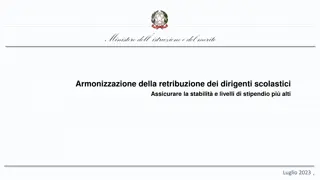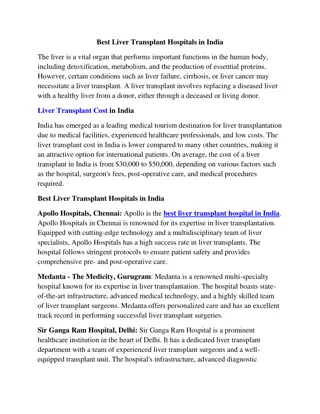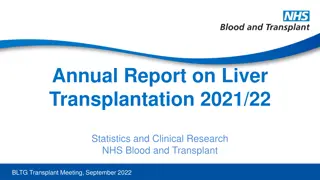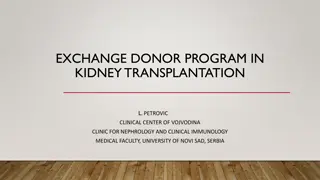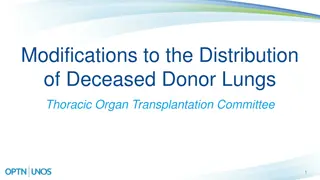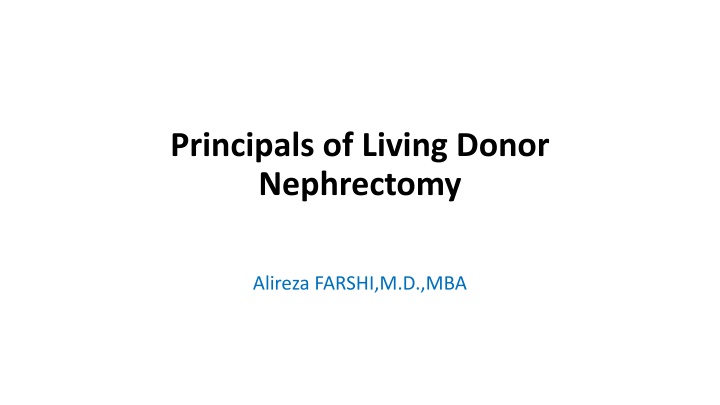
Living Donor Nephrectomy: Need, Advantages, and Global Impact
Learn about the ongoing need for living kidney donors in 2021 due to organ shortage, the advantages of living donor transplants over deceased donors, and the impact on pediatric recipients. Discover why living donation remains crucial in overcoming organ scarcity worldwide.
Download Presentation

Please find below an Image/Link to download the presentation.
The content on the website is provided AS IS for your information and personal use only. It may not be sold, licensed, or shared on other websites without obtaining consent from the author. If you encounter any issues during the download, it is possible that the publisher has removed the file from their server.
You are allowed to download the files provided on this website for personal or commercial use, subject to the condition that they are used lawfully. All files are the property of their respective owners.
The content on the website is provided AS IS for your information and personal use only. It may not be sold, licensed, or shared on other websites without obtaining consent from the author.
E N D
Presentation Transcript
Principals of Living Donor Nephrectomy Alireza FARSHI,M.D.,MBA
Living Donor Living kidney donation has successfully improved the lives of many patients worldwide for over half a century. Do we still have the same need for living donors in 2021? The answer is obviously yes and for many reasons.
Living Donor The first is organ shortage with a widening gap between renal supply and demand in all countries that increases every year despite the use of marginal deceased donors. The site of the US Government Information on Organ Donation and Transplantation, organdonor.gov, shows recently a transplant waiting list of more than 114,000 patients of whom 83% are potential kidney recipients. Waiting lists are growing everywhere.
Living Donor The second reason is the significant graft survival advantage and the reduction of the waiting time between end-stage renal disease and graft implantation. The results of renal transplantation from living donors are better compared to those from cadaveric kidneys with a graft half-life of 18 versus 12 years, respectively.
Living Donor The third reason stands for pediatric recipients where a prompt transplantation from a living donor, mostly a parent, can help for a better growth, quick return to school, and a good psychological stability; It is considered today as the gold standard therapy for children with end-stage renal disease.
Living Donor The fourth argument is that living donation provides a good opportunity to perform a preemptive transplantation avoiding the need of going through dialysis. A fifth reason is that we are still too far to overcome organ shortage by using xenografts from transgenic animals, or engineered organs from stem cells.
Living Donor Currently, 40% of kidney grafts in the United States are from living donors. In Europe, the level is highly variable between countries, standing for approximately 10% in France and up to 60% in Norway and Sweden. Approximately, one in three kidney transplants performed in the UK are from living donors. In some countries, namely Middle Eastern and Eastern, kidney transplantation is relying only or mostly on living donors.
Living Donor The first true altruistic voluntary living donation happened in Paris at Necker Hospital on December 1952, when a mother, Gilberte Renard, convinced the medical team to give her kidney to her son Marius, 16 years old. Unfortunately, the graft remained functional for approximately 3 weeks despite the use of steroids and Marius died on January 27, 1953. His donating mother died in 1992 at age 85.
Living Donor The second important milestone happened 1 year later on December 1954 at Brigham Hospital in Boston USA, when Dr. Murray performed a successful renal transplantation on Richard Hersick, the donor being his monozygotic identical twin brother Ronald. No effort was made to preserve the isograft; but nonetheless, it functioned promptly despite 82 min of warm ischemia. The graft remained functional for 8 years and was lost due to a recurrence of the renal disease and causing the death of Richard.
First kidney transplantation in the world 1954 Prof. Joseph E. Murray Nobel Prize (1990)
Organ Shortage Every ten minutes, someone is added to the national transplant waiting list. On average, 22 people die each day while waiting for a transplant. One organ donor can save eight lives.
Adult Kidney Graft Survival Rates 1995- 2005 100% 96% 93% 90% 90% 90% 87% 86% Percentage 81% 80% 80% 76% 72% 70% 65% 60% 55% 50% 1 year 2 year 3 year 4 year 5 year 10 year Living Donor Deceased Donor Source: UW Health Transplant database. Represents the total number of kidney transplants from 1/1/1995 through 12/31/2005. Includes all kidneys transplanted, including multi-organ transplants. 01/24/2007
From the surgical point of view, all donor nephrectomies were done by open techniques mostly using a lumbar retroperitoneal approach; and the first successful trial of removing a live donor kidney using a laparoscopic approach was in 1995 at John s Hopkins hospital by Ratner et al. Since then, considerable numbers of transplant centers worldwide have adopted laparoscopic donor nephrectomy (LDN) which is now considered as the gold standard approach for kidney retrieval on live donors and has undoubtedly revolutionized kidney donation.
Evaluation Although donors are not true patients, they must undergo a complete and extensive evaluation before considering kidney removal. This evaluation includes medical and surgical past history, risk factors like alcohol intake and smoking, family history (mainly renal disease, hypertension, and diabetes), renal, liver, and cardiopulmonary function. Active HBV and HCV are usually contraindications to living donor kidney donation; and HIV infection is an absolute contraindication.
Living Donor Criteria 18 years of age or older Good physical & mental health No chronic kidney stones No diabetes No current/recent cancer Not a lot overweight High blood pressure may be considered Other medical issues checked case-by-case
open surgery The mini-incision Laproscopy Living donor laparoscopic nephrectomy (transperitoneal or retroperitoneal) is a safe procedure with minimal associated mortality
Laparoscopic Donor Nephrectomy Vs Open Donor Nephrectomy 1. Serum Creatinine - 1 week to 1 month after Transplant significantly higher in Laparoscopic group compared to open group 3 & 6 months similar in both groups 2. Number of Ureteral complication higher in Lap. group compared to open group Current series show complication rate higher during early part of experience. Later on there is no statistical difference
Surgical steps Surgical steps taking the colon off the kidney medially along the Toldt s fascia Gerota s fascia is left intact on the kidney All periureteral and inferior renal pole fat must be well preserved to keep a wellvascularized ureter The gonadal vein can be divided proximally and distally and kept with the ureter in order to protect ureteric vascularity(postoperative ipsilateral orchialgia)
Surgical steps Surgical steps
Surgical steps Surgical steps The ureter and its peri-ureteral fat are lifted up to undertake an upper dissection along the genital vein until we reach the inferior border and the anterior aspect of the renal vein then proceed to adrenal dissection with division of the adrenal vein without any clip placement and caring not to injure the anterior branch of the renal artery
Surgical steps Surgical steps The left renal artery is dissected at its aortic origin Endo-TA stapler is used to ligate the renal vessels (Teleflex Medical, added a contraindication to the use clips on renal vessels in laparoscopic live donor nephrectomy) Clip dislodgement may occur several hours following the procedure resulting in fatal hemorrhage on the ward. Stapling starts on the renal artery and then quickly on the vein, and the kidney is rapidly placed in the Endo bag and extracted.
Surgical steps Surgical steps
Open versus Laparoscopic Several meta-analysis compare open and laparoscopic donor nephrectomy. The overall results demonstrate that the laparoscopic technique is associated with a significantly shorter hospital stay, fewer postoperative analgesic requirements, improved cosmetics and a quicker return to work as compared with open donor nephrectomy.
Open versus Laparoscopic This raises the question of the learning curve and how many laparoscopic nephrectomies should be done before performing the first LLDN? There is no precise answer but a number between 50 and 100 seems to be convincing for this type of surgery to be learned.
Intraoperative factors Left or right kidney Most centers prefer to use the left kidney for living kidney donation because the renal vein is longer, which is advantageous during implantation A single-center randomized controlled trial revealed no differences between left- and right-sided donor nephrectomy. Minnee RC, Bemelman WA, Maartense S, Bemelman FJ, Gouma DJ, Idu MM. Left or right kidney in hand- assisted donor nephrectomy? Arandomized controlled trial. Transplantation. 2008;85(2):203-8.
Intraoperative factors Multiple renal arteries and veins Multiple renal arteries are present in 12 to 33%. Multiple arteries has been associated with an increased incidence of vascular and urological complications, such as thrombosis and ureteral ischemia, and was considered a relative contraindication by some surgeons.
Intraoperative factors Multiple renal arteries and veins more recent reports state that renal transplantation can be performed safely in case of multiple arteries Special care has to be taken with the lower kidney pole accessory renal arteries. It can be concluded that regardless of which technique (open or laparoscopic) used multiple vessels are not a contraindication.
Intraoperative factors Warm ischaemia time In general, especially in the early years laparoscopic techniques had a longer warm ischemia time than the open techniques but increased experience have reduced these long warm ischemia times because of these adjuncts to laparoscopic techniques the warm ischemia time is almost identical to open techniques. there is no clinically demonstrated negative effect on kidney function if the warm ischemia time is less than 10 minutes
Intraoperative factors Older donors Due to the increasing organ shortage, more and more transplant centers are retrieving kidneys from older donors. The use of older living donors remains controversial because of the physiological decline in glomerular filtration rate beginning in the third decade of life and an increased risk of surgical complications for the older kidney donor. older than 60 years associated with larger increases in blood pressure. In a prospective study there were no significant differences in intraoperative and postoperative complication rates or in the one-year graft survival rate between younger and older donors.
Intraoperative factors Obese donors obesity is recognized as an independent cardiovascular risk factor and has also been shown to be a significant risk factor for complications following major surgery, including living kidney donation obesity has been recognized as an independent risk factor for end-stage renal disease. Delayed graft function was more common among recipients of kidneys from very obese donors. Nevertheless, obese donors are accepted in donor selection programs.
Intraoperative factors Obese donors obese patients should undergo careful preoperative evaluation to exclude cardiovascular, respiratory and renal disease. They should be counselled regarding the increased perioperative risk and potential long- term risk of renal disease and advised to lose weight prior to donation and encouraged to adopt a healthy lifestyle. Open surgical nephrectomy in obese subjects is associated with higher rates of postoperative complications, primarily wound related.
Complications LLDN appears to be a safe procedure or at least as safe as the open one. But serious complications including death may occur. Overall mortality rate is approximately 0.03%. Most of these deaths occurred in the postoperative period and were due to a) hemorrhage b) CO2 gas embolism c) and pulmonary embolism
Intraoperative complication Intraoperative hemorrhage Conversion to open surgery splenic or liver laceration, ureteral and intestinal injury, and pleural laceration. All major complications occurred in the first 100 cases
Postoperative complications hematomas, fever, urinary tract infection, pneumonia, pulmonary embolism, wound infection, incisional hernias, prolonged ileus, chylous ascites, and left testicular pain perhaps due to gonadal vein division.
Conclusion Living donation is a success story that saved many patients with end-stage renal disease from dialysis and offered them a better quality of life and longer life expectancy. Donor surgery has shifted from the old open technique to a mini-invasive approach that offers less pain to this category of people who are not true patients but true heroes full of courage and nobility.
Postoperative factors Postoperative factors Complications The described mortality risk for open and laparoscopic nephrectomy is 0.03%. The complication rate of donor nephrectomy is approximately 10%. By comparison, pulmonary complications, including atelectasis, pneumothorax, pulmonary congestion, hypoxia, thrombophlebitis, intramural thrombus, and deep vein thrombosis, were reported more often after open donor nephrectomy than after laparoscopic donor nephrectomy.
Postoperative factors Postoperative factors Complications Vascular complications, in particular injury to renal arteries and veins, were reported more often for laparoscopic donor nephrectomy patients, whereas fever, pain, and nausea were reported more often for open donor nephrectomy patients.





